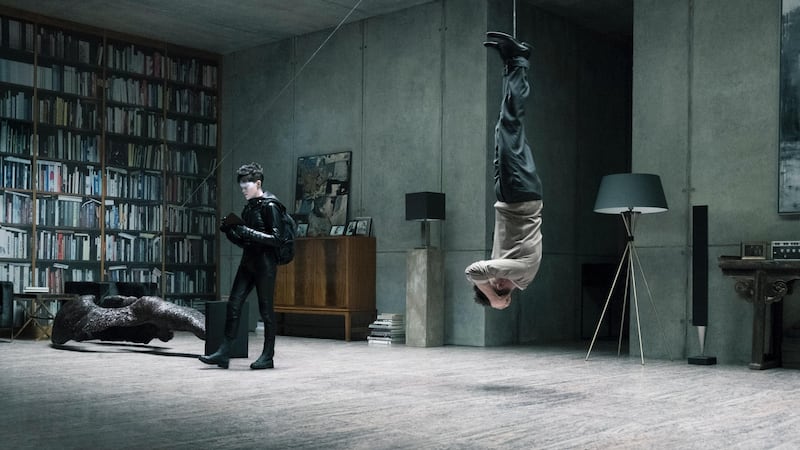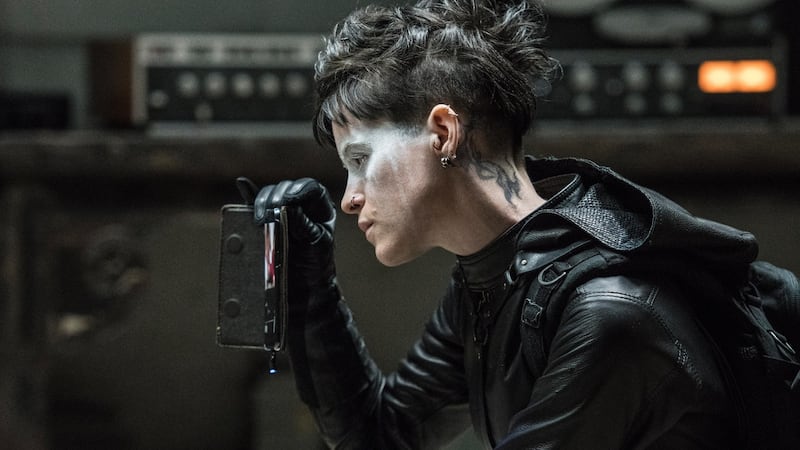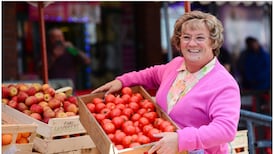To the Rome Film Festival for the world premiere of The Girl in the Spider's Web. You picture limousines jockeying for position on the Via Veneto. You imagine some successor to Marcello Mastroianni elbowing his way towards a descendent of Anita Ekberg. You know? Like in La Dolce Vita.
The reality is different. It may come as a surprise to learn that the Rome Film Festival came into being as recently as 2006. Nobody is likely to confuse it with its much older, much more distinguished cousin in Venice. Particularly not tonight. The premiere is taking place at the Parco della Musica, a few miles to the northeast of the ancient city. Renzo Piano's trio of buildings, rounded in the style of enormous slugs, is elegant, but the grounds – around which the red carpet winds – offer too many suggestions of a German industrial park. Marcello stares sadly from a poster as Sigourney Weaver, here for some presentation or other, makes her way past modest huddles of fans in Ghostbusters costumes.
Lisbeth – a better Batman than the current Batman – speeds her way about the meaner streets of Stockholm
The interior is stranger still. It's a very nice concert hall. But it's inarguably a concert hall. When Claire Foy, who plays Lisbeth Salander in the latest addition to the Millennium series, arrives in glory we half-expect her to pull out a fiddle and give us a few bars of Mozart's Third.
She doesn't. But Fede Álvarez's film is odd enough in itself. Adapted from David Lagercrantz's continuation of Stieg Larsson's blockbusting trilogy, the picture sends the tattooed avenger in pursuit of evil computer hackers as they plot to access the world's nuclear arsenal. Mikael Blomkvist, the journalist who once seemed the series' protagonist, is edged into the wings while Lisbeth – a better Batman than the current Batman – speeds her way about the meaner streets of Stockholm.

So, how did we get here? The three original Swedish films, starting with The Girl With a Dragon Tattoo, did respectable overseas business and made a mid-level star of Noomi Rapace. Then David Fincher set to work on his characteristically miserable, shadowy and overlong English-language version. Seven years after that film's release, we have jumped past the succeeding two Larsson novels – the writer died in 2004 after sampling only a smidgeon of the success to come – and moved onto Lagercrantz's indifferently received continuation. Foy replaces Rooney Mara. Sverrir Gudnason replaces Daniel Craig in the role of Blomkvist.
The day after the premiere, Álvarez, Uruguayan director of the excellent horror Don't Breathe, is being diplomatic about the complex shenanigans.
"I know they tried and probably Fincher didn't find a script he wanted to do," he says. "Then I was presented with a script by Stephen Knight for the fourth. I would never have made a film of the second or the third because the stories are direct continuations."
Yeah, all right then. It would not require enormous reservoirs of cynicism to conclude that some downsizing has taken place. The Fincher film took in a relatively disappointing $231 million (€201 million). The release was not a disaster for the studio, but it was underwhelming enough for Gary Barber, then chief executive officer of MGM Holdings, to admit: "it is below our expectations and we booked a modest loss".
Possible sequel
Nonetheless, Fincher was still making noises about a possible sequel when promoting Gone Girl in 2014. "I think because [Sony] already has spent millions of dollars on the rights and the script it will result in something," he said. "The script that we now have has huge potential. I can reveal as much, as it is extremely different from the book." Mara also declared herself available, but The Girl Who Played With Fire never got to the starting grid.
Made for less than half of the $90 million (€78.3 million) that Fincher ate up on Dragon Tattoo, the new film is leaner, faster and less up itself. They have done well in their lead. Still best known for her role as Queen Elizabeth II in The Crown, Foy whitens her face, teases her hair and squeezes her vowels to play convincingly against her assumed type.

She does sound less posh than the queen, I'll give her that
“I have an aversion to be being told I have to look a certain way to be an actress,” she says. “It might be nice to play somebody glam . . . That was never something I thought was important. I did what I always do with Lisbeth: I fought for what I thought was right. I didn’t need to be looking approachable.”
Wearing striking green jeans that might be made from leather (like I know), Foy looks at home in Rome's eye-wateringly swanky Eden Hotel. She is articulate, polite and interested. Ask her a question and she'll poke through the undergrowth in search of an answer. The familiar pinched features from The Crown wrinkle at less welcome questions, but she is never unfriendly.
I wonder if people expect her to be posh.
“No. I think most people on meeting me for five seconds would tell that I am not,” she says.
I’m not altogether sure that’s so. Born in Manchester to an Irish family – Dublin and Kildare, apparently – she was raised in Buckinghamshire and still speaks in a precise home-counties accent. She does sound less posh than the queen though. I’ll give her that.
“Pain plays a big part in all the characters I play,” she says. “Whenever I play a character I do like to find what it is that has deeply hurt them the most. That’s what formulates the character: the things you long for, the things you can’t let go of, the things you wish you could change about yourselves or other people. That’s when I get to know any character.”
That's an interesting take. The character of Lisbeth Salander has taken on particular resonance over the last year or so. Larsson's original title for The Girl With the Dragon Tattoo was, in English, Men who Hate Women and her appeal has always been tied to her status as a survivor of sexual abuse who stands up for current victims.
Everyone would love to have a go at being <a class="search" href='javascript:window.parent.actionEventData({$contentId:"7.1213540", $action:"view", $target:"work"})' polopoly:contentid="7.1213540" polopoly:searchtag="tag_person">Grace Kelly</a>. It doesn't mean glamorous just for the sake of it
“Yeah. I think to a lot of people what she represents is that she’s been a victim of sexual abuse,” Foy says. “There’s so much shame in society about that. That’s why so many women are not given the forum in which they can speak about it personally. The survivor is not protected. It’s as if they should feel ashamed, which is a very odd and wrong thing. To have a character who is a survivor and is able to be seen is so important. She’s still there.”
Foy is on a significant roll. Earlier in the year, she took control of Stephen Soderbergh's experimental thriller Unsane. As we speak she's gearing up for an exhausting Oscar campaign that – unless all the bookies are wrong – should deliver a best supporting actress nomination for Damien Chazelle's First Man. She's excellent as Neil Armstrong's wife in that film, but Salander feels like an even more dramatic lurch away from the shadow of The Crown. Different sorts of crushing expectations hang over the queen and the Swedish righter of wrongs.
“I think that is the perverse reason I enjoy playing these parts,” she says. “From the beginning you’re on minus 50 points. You’re starting from a point that you’re the underdog. How is anyone going to be Lisbeth Salander? It’s not about proving people wrong. I don’t think I’ve achieved that. I know I never will. I have to devolve myself from that and follow my own instincts.”
So she felt herself under pressure as the queen?
"I always find the underdog," she says. "The second season of The Crown was different because we'd already started shooting the series before it came out. People liked it. Then it was: let's see if we can do this without f***ing it up. Ha ha! There's always a way of doing that."
A little glamorous
Earlier, she said something interesting about hoping sometime to play a properly glamorous part. Most people would find the queen just a little glamorous. She doesn't have the flash of Princess Margaret, but she gets to wear actual crowns and chat with president Kennedy.
"Everyone would love to have a go at being Grace Kelly, " she says. "It doesn't mean glamorous just for the sake of it. The queen doesn't move towards glamour. She's much more comfortable in a pair of wellington boots than she is in a gown."
She does some more thinking about it.
“A romcom would be very exciting,” she says. “I would do the same thing with that. What does my character feel?”
Now 34, Foy, who has a young daughter from her relationship with former husband Stephen Campbell Moore, has established a position in the British theatrical establishment. Ten years ago she played the title role in the BBC's adaptation of Dickens's Little Dorrit. She was Anne Boleyn in Wolf Hall. Olivia Colman has taken over her role in The Crown as that series moves towards Beatlemania and the decline of deference. The premiere in Rome feels like a pivot towards another phase of the career.
We’ve got through all this without me wrapping myself in the flag and getting her to say something about Ireland. The paper is legally obliged to do that, you know. She genuinely cackles at the absurdity of the promotional circus and then obliges with no hint of facetiousness.
“Ha ha ha! Ireland, Ireland, Ireland. The best place in the world!” she says.
That will do.
“Oh, I have no desire to make people think I am anything in particular,” she continues warmly. “You can’t control it. People will either love you or hate you or be indifferent to you. It doesn’t matter what you do.”
Ekberg said something similar during the press conference in La Dolce Vita. Didn't she?
Who’s becoming whom in The Crown?
As the Netflix series examining the British monarchy moves towards season three there is much shuffling of cast members.
The queen
Claire Foy becomes Olivia Colman. The two actors should see much of one another over the next few months as they campaign for Oscar nominations in respectively First Man and The Favourite.
Prince Philip
Matt Smith becomes Tobias Menzies. Just eight years older than the former Doctor, Menzies is a legend among fans of time-travelling bodice-ripper Outlander.
Princess Margaret
Vanessa Kirby becomes Helena Bonham Carter. Everyone loves this. The breakout star of the first series – great in the last Mission: Impossible film – Kirby gives way to theatrical aristocracy.
Queen Elizabeth, the queen mother
Victoria Hamilton become Marion Bailey. Here's a top fact. The queen mum will now be played by Mike Leigh's wife.
Prince Charles
Julian Baring hands over to dishy, rising star Josh O'Connor. You will recall him shagging muddily in Francis Lee's God's Own Country.










